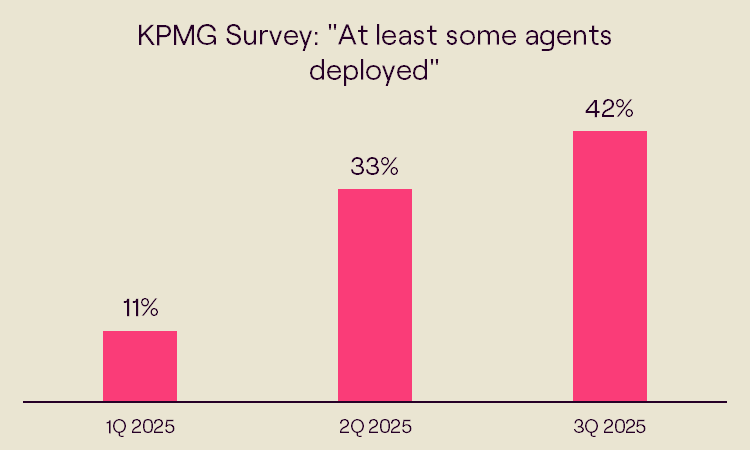# State of Agentic AI: Founder’s Edition
## Introduction: Lessons from Clippy
If you’ve never heard of **Clippy** — Microsoft’s infamous paperclip assistant from 1996 — count yourself lucky. Introduced in Microsoft Office (ancestor to today’s Word and Excel), Clippy became [the world’s most hated virtual assistant](https://www.mentalfloss.com/article/504767/tragic-life-clippy-worlds-most-hated-virtual-assistant) for its uninvited and intrusive suggestions, until it was shut down in 2007.
Why revisit this relic? Because while history rarely repeats exactly, it often **rhymes**.
With all the current hype around **agentic AI** (intelligent, autonomous agents), and Gartner’s bold [prediction](https://www.gartner.com/en/newsroom/press-releases/2025-06-25-gartner-predicts-over-40-percent-of-agentic-ai-projects-will-be-canceled-by-end-of-2027) that **40% of agentic AI projects will be abandoned by 2027**, key questions arise:
- What will it take for AI agents to succeed in production at scale?
- How can they delight users instead of annoy them, becoming copilots rather than modern-day Clippys?
## Research Approach
To explore these questions, we:
- Surveyed **30+ top European agentic AI startup founders**
- Interviewed **40+ industry practitioners**
- Mapped current industry dynamics and best practices — creating a practical “playbook” based on patterns observed among successful teams
The result blends **quantitative findings** with founders’ candid insights.
---
## Key Findings — TL;DR
- **Non-technical challenges** dominate:
- Workflow integration and UI issues (**60%**)
- Employee resistance (**50%**)
- Privacy and security concerns (**50%**)
- Winning strategies embrace a **“Think Small”** rollout:
- Start with *low-risk, moderately impactful, verifiable* tasks
- Deliver visible ROI fast, frame as augmenting human work
- Target disliked tasks first
- **Funding shift**:
62% of startups now draw from **Line-of-Business (LoB)** budgets — a sign AI agents are escaping the “innovation experiment” bucket
- **Pricing evolution**:
- Hybrid (23%) and per-task (23%) most common
- Outcome-based pricing rare (3%) due to attribution & measurement complexity
- **Infrastructure trend**:
52% build *entirely in-house* agent frameworks — ecosystem still immature
---
## The Bigger Picture
Agentic AI’s progress depends as much on **human adoption and seamless integration** as on raw model capability. Mature deployment demands end-to-end tooling: generation → publishing → analytics → deployment.
For example, [AiToEarn](https://aitoearn.ai/) is an open-source, multi-platform AI content monetization tool integrating all those layers, publishing to Douyin, Bilibili, LinkedIn, YouTube, Instagram, and X, while tracking impact via [AI model ranking](https://rank.aitoearn.ai).
---
## What Exactly is an AI Agent?
For this research, AI agents are defined by:
1. **Goal Orientation** — Clear objectives drive all actions.
2. **Reasoning** — Adaptive planning that breaks down complex goals into smaller tasks.
3. **Autonomy** — Acts without constant human input (including tool calling).
4. **Persistence** — Maintains memory and state across sessions.
Multi-Agent Systems (MAS) take this further by:
- Distributing workload across specialized agents
- Sharing memory & goals
- Coordinating on complex, open-ended problems
- Improving efficiency, fault tolerance, flexibility
---
## Why Not Just Use RPA?
Unlike **Robotic Process Automation** (rule-bound scripts), AI agents handle:
- **Dynamic and unstructured tasks**
- **Edge cases** without failure
- **Reasoning-based decisions**
- **Real-time adaptability**
They evolve and learn — often making them a better fit for complex workflows.
---
## Enterprise Deployment Patterns
Surveys (e.g., [KPMG Q3 2025](https://view.ceros.com/kpmg-design/kpmg-genai-study/p/1)) show adoption quadrupling since early 2025. However:
- Deployments are often **small-scale**
- Common domains: customer support, sales & marketing, cybersecurity, developer productivity
- Shadow AI risk — employees use unapproved tools via personal accounts
- Autonomy remains limited in practice — ~50% human-in-loop norm
---
## Survey Insights
Core focus areas:
- [Accuracy & autonomy levels](https://mmc.vc/research/state-of-agentic-ai-founders-edition/#agentic-accuracy-autonomy)
- [Pricing strategies](https://mmc.vc/research/state-of-agentic-ai-founders-edition/#agentic-pricing-strategies)
- [Budget sources](https://mmc.vc/research/state-of-agentic-ai-founders-edition/#agentic-budgets)
- [Deployment challenges](https://mmc.vc/research/state-of-agentic-ai-founders-edition/#agentic-deployment-challenges)
- [Infrastructure build vs. third-party tools](https://mmc.vc/research/state-of-agentic-ai-founders-edition/#agentic-infra-own-vs-third-party)
---
## Autonomy & Accuracy Configurations
**Link between accuracy & autonomy**:
- **Over 90%** report ≥70% accuracy
- Only **66%** operate at ≥70% autonomy
**Three main configurations**:
1. **Medium Accuracy, High Autonomy** — OK for low-risk, high-volume tasks or unlocking new capabilities.
2. **High Accuracy, Low Autonomy** — Common in healthcare; accuracy >90%, autonomy ~40%.
3. **High Accuracy, High Autonomy** — Financial/compliance use cases; blending probabilistic LLMs with deterministic methods.
---
## Pricing Models
### Common Approaches
- **Outcome-Based** — High appeal, hard to implement (attribution/measurement complexity)
- **Per-User** — Clear for copilots; less suited for high-autonomy
- **Per-Agent** — Maps to personnel costs; emphasis on *new capabilities*
- **Per-Task** — Flexible; ties directly to consumption
- **Hybrid** — Base fee + usage/performance variable
### Funding Shift
AI agents increasingly funded from *core business budgets*, not just innovation pools.
---
## Top Deployment Challenges
1. **Workflow Integration & UI** — Conceptual (process redesign) + practical (embedding where users work)
2. **Employee Resistance** — Linked to trust levels; higher autonomy drives skepticism
3. **Privacy & Security** — Real vs. perceived risks slowing adoption
4. **Legacy Tech Stacks** — API scarcity, fragmented data, poor documentation
---
## Observability, Privacy, Data, and Infra
- **Observability & Monitoring** — Required for trust and error detection, especially in multi-agent systems
- **Data Quality/Infra** — Heavy “data cleaning” needed; process documentation often stale
- **Infra Costs** — Token bloat in reasoning models; throughput vs. quality trade-off
- **Infra Build** — 52% entirely in-house due to early-stage ecosystem
---
## Deployment Best Practices
### Strategic Rollout
Start with:
- Small, concrete, low-risk use cases
- Tasks disliked by humans
- Easily validated outputs
- Rapid ROI examples
### Land & Expand
Adopt **one use case at a time**, earn trust before scaling complexity.
### Hands-On Guidance
Workshops, readiness assessments, consultative GTM to set expectations.
### Roles & Interfaces
Forward Deployed Engineers (FDEs) embed with clients for complexity-heavy deployments.
---
## Positioning Strategies
### Autonomy Framing
Sell as *copilot* even if full autonomy possible — builds trust.
### Augmentation Over Replacement
Emphasize value-add to existing workflows rather than “rip-and-replace”.
### ROI Communication
- Easier when fitting known workflows (time, cost, revenue)
- Harder when unlocking novel capabilities — position alongside familiar tools for measurable impact.
---
## The Road Ahead — Ideal Endgame
The future will see:
- **Ambient agents** — proactive, initiating actions without prompts
- **Inter-agent collaboration** — negotiating, hiring, partnering across org boundaries
- **Resilience under uncertainty** — robust to adversarial conditions
Key developments needed:
1. Rich context & memory management
2. Reliable, secure action execution
3. Trustworthy & adversarial-robust architectures
---
## Final Note
As with content monetization platforms like **[AiToEarn](https://aitoearn.ai/)**, integration, measurable utility, and cross-platform presence will play central roles in scaling agent adoption beyond novelty — toward indispensability.
**Source:** [https://mmc.vc/research/state-of-agentic-ai-founders-edition/](https://mmc.vc/research/state-of-agentic-ai-founders-edition/)





